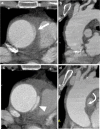A pictorial review of acute aortic syndrome: discriminating and overlapping features as revealed by ECG-gated multidetector-row CT angiography
- PMID: 23129238
- PMCID: PMC3505562
- DOI: 10.1007/s13244-012-0195-7
A pictorial review of acute aortic syndrome: discriminating and overlapping features as revealed by ECG-gated multidetector-row CT angiography
Abstract
Background: The term "acute aortic syndrome" (AAS) encompasses a spectrum of life-threatening conditions characterized by acute aortic pain. AAS traditionally embraces three abnormalities including classic aortic dissection, intramural haematoma, and penetrating atherosclerotic ulcer. Although the underlying etiologies and conditions predisposing to AAS are diverse, the clinical features are indistinguishable.
Methods: Multidetector-row computed tomography (CT) with electrocardiographic gating (ECG-gated MDCT) has greatly improved imaging of acute thoracic aortic diseases by virtually eliminating pulsation artifacts transmitted from cardiac motion and reveals subtle aortic abnormalities, which have been difficult to recognize by conventional non-gated CT.
Results: While these advances in imaging technology provide additional discriminating features of acute aortic diseases, they also reveal a range of overlapping features of these life-threatening conditions that not uncommonly are dynamic and evolving. These overlapping and transitional features may be a major source of misunderstanding, confusion, and controversy for diseases that cause AAS.
Conclusion: In this pictorial review, we describe the discriminating and typical imaging features as revealed by modern ECG-gated MDCT angiography. In addition to the discriminating features, recognition of the overlapping and transitional features in AAS will allow a more comprehensive understanding of their underlying pathophysiologic conditions and their natural history, and may improve therapeutic management.
Main messages: • The superior visualization of ECG-gated CTA improves the diagnostic accuracy of acute aortic syndrome. • ECG-gated CTA provides discriminating features of underlying pathophysiologic conditions of AAS. • Also, recognition of the overlapping features in AAS will allow a more comprehensive understanding.
Figures










References
-
- Hiratzka LF, Bakris GL, Beckman JA, et al. ACCF/AHA/AATS/ACR/ASA/SCA/SCAI/ SIR/STS/SVM guidelines for the diagnosis and management of patients with Thoracic Aortic Disease: a report of the American College of Cardiology Foundation/American Heart Association Task Force on Practice Guidelines, American Association for Thoracic Surgery, American College of Radiology, American Stroke Association, Society of Cardiovascular Anesthesiologists, Society for Cardiovascular Angiography and Interventions, Society of Interventional Radiology. Circulation. 2010;121:e266–369. doi: 10.1161/CIR.0b013e3181d4739e. - DOI - PubMed
-
- Vilacosta I, Aragoncillo P, Canadas V, San Roman JA, Ferreiros J, Rodriguez E. Acute aortic syndrome: a new look at an old conundrum. Heart. 2009;95:1130–1139. - PubMed
-
- Shiga T, Wajima Z, Apfel CC, Inoue T, Ohe Y. Diagnostic accuracy of transesophageal echocardiography, helical computed tomography, and magnetic resonance imaging for suspected thoracic aortic dissection: systematic review and meta-analysis. Arch Intern Med. 2006;166:1350–1356. doi: 10.1001/archinte.166.13.1350. - DOI - PubMed
LinkOut - more resources
Full Text Sources

